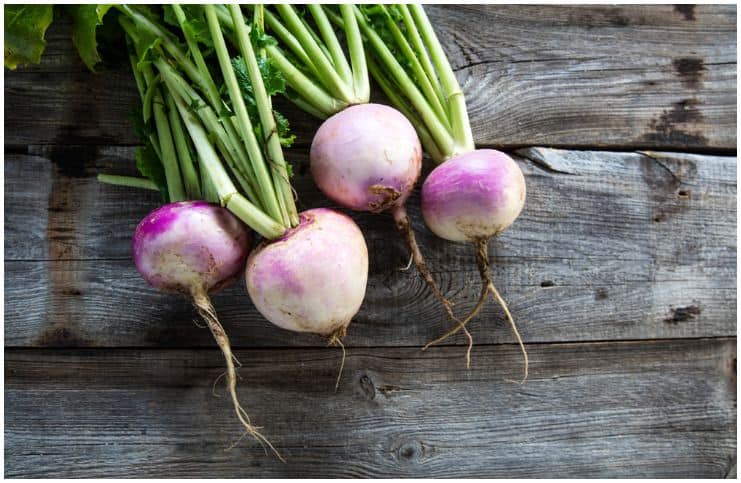Rutabaga (scientific name – Brassica napus) is a root vegetable from the cruciferous vegetable family which is believed to have originated in the 17th century in Bohemia.
The roots can be prepared similarly to potatoes — roasted, baked, steamed, or sautéed, or they can be eaten pickled or raw.
Nutrition Facts
Regarding organic compounds, this vegetable provides vitamin A (in the form of carotenoids), choline, calcium, magnesium, iron, phosphorus, manganese, zinc, potassium, thiamin, vitamin C, riboflavin, niacin, vitamin B5, and folate.
Also, it is a source of glucosinolates, compounds that are responsible for the pungent aroma and bitter taste of cruciferous vegetables. Also, it contains high amounts of fatty acids, like – omega-6 and omega-3 fatty acids in the correct proportion.
The leaves are also edible (they are full of minerals and vitamins), and can be cooked just like mustard greens and other edible greens.
Health Benefits
Cancer Prevention
This cruciferous vegetable is a remarkable source of sulfur-containing substances called glucosinolates.
Eating foods rich in glucosinolates can help reduce the risk of prostate cancer, according to a study done at the University of Washington Seattle Cancer Care Alliance.
Good For Diabetics
It is a storehouse of dietary fiber, mainly insoluble fiber, a type of dietary fiber that does not break down within the digestive tract.
According to the Harvard School of Public Health, a high intake of dietary fiber protects against disease, plus, individuals who consume enough dietary fiber enjoy a reduced risk of colon cancer, constipation, and diabetes mellitus.
100g contains 1,8g of dietary fiber, which is about 7 percent of the daily recommended intake.
Vitamin C
This vitamin is a potent antioxidant known to prevent disease and illness and enhance the immune system. Eating foods rich in vitamin C reduces the toxic effects of chemotherapy for some cancer patients, according to research done at the University of Kansas Medical Center.
100g of this vegetable has 18,8 mg vitamin C which is approximately 31 percent of the daily recommended intake.
Cardiovascular Health
Potassium is an essential mineral for the function of a few organs, including the kidneys, heart, muscular tissues, and brain. Also, it’s the 3rd most abundant mineral in the human body.
The World Health Organization recommends an intake of 3,510 mg a day, however, according to the data, most people are not meeting this recommendation. A deficiency in potassium may cause pain in the intestines, high blood pressure, type 2 diabetes, or swelling of the glands.
100g of this cruciferous has 326 mg potassium which is 9 percent of the daily recommended intake.
Side Effects
There are no scientifically proven side effects.
Turnip
It is a highly nutritious cruciferous root vegetable which belongs to the Brassicaceae family, which also includes superfoods, such as – collards, kale, cabbage, broccoli, and brussels sprouts.
This vegetable is known as “Neep” in the Northern part of England and Scotland. Its greens are used in soups and stews, whereas their bulbous roots are usually chopped or diced and pickled.
Nutrition Facts
It is a good source of folate (also known a vitamin B9), dietary fiber, protein, manganese, magnesium, potassium, omega-3 fatty acids, selenium, calcium, iron, copper, thiamin, riboflavin, vitamin C, vitamin B6, and phosphorus.
One cup of its leaves has more than 1/3 of the daily requirement for vitamin C as well as more than 33 percent of the daily intake of vitamin A (in the form of carotenoids), which is about 700 mcg for women and 900 mcg for men.
Health Benefits
Weight Loss
A regular diet rich in dietary fiber has been shown to reduce the prevalence in flare-ups of diverticulitis (pouches which form in the wall of the colon) by absorbing water in the large intestine and making bowel movements easier to pass.
Moreover, when the digested soluble fiber is combined with the liquid in the digestive tract that gives it a gel-like consistency, it increases the level of satiety after a meal, which in turn helps to maintain a healthy weight.
100g contains 1,8g of dietary fiber which is approximately 7% of the daily recommended intake.
Enhances Collagen Production
Vitamin C is essential for many functions in the human body. Interestingly, unlike most animals, we are unable to synthesize this vitamin endogenously, hence, we need to get it daily from the diet.
Vitamin C also helps maintain the integrity of our bones, connective tissue, and blood vessel walls since it is involved in the production of collagen.
It is also an essential antioxidant that helps protect cells from damage caused by free radicals which we are regularly exposed to in the environment, like – cigarette smoke, air pollution, and ultraviolet light from the sun.
100g of this cruciferous has 21 mg of vitamin C which is about 35% of the daily recommended intake.
Manganese
It is known as an essential trace material, meaning that it’s needed in a very small amount by the human body for sexual hormone stimulation, blood clotting, proper functioning of the brain, and formation of tissues.
A deficiency in this mineral can interfere with both the creation of specific key enzymatic reactions and important enzymes required for good health.
100g of this cruciferous vegetable has 0,1 mg manganese which is 7 percent of the daily recommended intake.
Side Effects
There are no scientifically proven side effects.
Rutabaga vs Turnip – Which Has A Better Nutritional Profile?
These vegetables vary in taste and appearance, but rutabagas are bigger and denser in numerous essential nutrients, especially vitamin B1, vitamin B6, phosphorus, and iron.
Image credit – Shutterstock
READ THIS NEXT: Rambutan vs Lychee
References http://academics.hamilton.edu/foodforthought/our_research_files/rutabaga.pdf https://www.ncbi.nlm.nih.gov/pmc/articles/PMC187589/ https://www.researchgate.net/publication/255984250_Rutabaga_Brassica_napu
